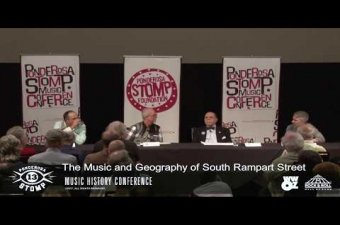Morris Music
168 S. Rampart StreetNew Orleans LA 70112
Morris Karnofsky grew up in a Jewish household on South Rampart Street, a predominantly Black area. His childhood was filled with music, from his mother singing Russian lullabies at night to brass bands parading past their house to the blues coming out of the Funky Butt dance hall down the street.
When Karnofsky drove his family’s wagon into Storyville to sell coal to the brothels, Louis Armstrong rode with him, blowing a little tin horn. At the time Armstrong was just a kid from around the corner. The Karnofskys employed him and welcomed him into their home, where he often had supper. When he spotted a cornet in the window of Jake Fink’s pawn shop next to the Eagle Saloon, they advanced him some pay to buy his first proper instrument.
In the 1920s, while Armstrong set the world on fire with his Hot Five and Hot Seven recordings, Karnofsky — who used the surname Karno as an adult — started Morris Music Co. on South Rampart. The store sold phonographs and records, and those who couldn’t afford to buy could rent them out for parties. The shop is remembered as the first record store in New Orleans to carry jazz albums.
In the 1930s, at 203-205 South Rampart, Morris Music expanded, selling instruments to school band programs and offering discounted instruments to students who signed up for private lessons from the company’s instructors.
By 1939, the operation settled here, at Morris Music House, and it became a neighborhood landmark. Karno set speakers outside, providing a soundtrack for the daytime foot traffic. At night, the neon sign glowed. Gwendolyn Midlo Hall — a cousin of Karno’s who would become a noted historian — worked here when she was sixteen.
As big bands and “race records” turned toward rhythm and blues in the late 1940s, the store’s speakers amplified the new sound. Their motto was “First with the latest hits!” The records Little Richard and Fats Domino cut at J&M Studio on North Rampart, just across Canal Street, played down the sidewalk here like they did across the country.
Armstrong visited Karno when he made trips back to New Orleans. International stardom didn’t diminish the warmth he felt for Morris and his family. They couldn’t have been too far from his mind when, later in life, he began wearing a Jewish star around his neck.
About South Rampart Street
South Rampart Street was the main commercial corridor in “back o’ town,” originally a swampy area at the back end of the city where New Orleans’ racial order relegated Black residents in the late 1800s. The strip filled with businesses—many run by Jewish, Italian, and Chinese merchants—catering to a Black clientele. Among these were dance halls, juke joints, tailors who outfitted bands with uniforms, and pawn shops that bought and sold instruments.
Churches here tended to be Protestant, with emotive spirituals and hymns in their services that reverberated through the neighborhood. To the ministers’ chagrin this area included Black Storyville, the red light district for those barred from the whites-only bordellos and gambling houses just across Canal Street. This traffic fueled some social ills. It also helped attract audiences for working musicians. (Business continued after 1917, when the white vice district—Storyville—shut down).
In 1938, the WPA City Guide called South Rampart “The Harlem of New Orleans.” It was full of music, from barrelhouse piano players like Tuts Washington to big bands like Papa Celestin’s. The street itself was a venue, with benevolent societies and social clubs parading with brass bands, and, on Carnival, the Zulu parade, Baby Dolls, and chanting bands of Mardi Gras Indians.
The strip was referenced in popular songs, from the traditional jazz tune “South Rampart Street Parade” to Louis Jordan’s jump blues hit “Saturday Night Fish Fry” in 1949, about a house on Rampart “rockin’” till the break of dawn.
While the “New Orleans sound” of R&B played across the country in the 1950s, South Rampart Street went the way of other Black inner city neighborhoods in the age of urban renewal. Whole blocks were demolished and redeveloped, paving the way for a new city hall and today’s Central Business District.
Videos

From the 2017 Ponderosa Stomp Music History Conference, Richard Campanella, Bruce Raeburn, and "Deacon" John Moore discuss music on South Rampart Street with Jordan Hirsch.
Video from Ponderosa Stomp.
From the 2017 Ponderosa Stomp Music History Conference, Richard Campanella, Bruce Raeburn, and "Deacon" John Moore discuss music on South Rampart Street with Jordan Hirsch.
Images
















